Don't wanna be here? Send us removal request.
Text


PRERANA SHINDE, ENVIRONMENTAL ARTIST
As an aspiring environmental artist, I find inspiration in various forms of art that merge creativity with ecological consciousness. Land art, eco art, and other environmental artists have instilled in me a deep appreciation for the natural world and a drive to make a positive impact through my artwork. Furthermore, my background in architecture and interest in Hindu architecture have shaped my artistic vision, leading me to create sculptures of endangered species and display them on construction debris.
Land art and eco art offer powerful examples of how art can interact with the environment and raise awareness about ecological issues. Artists like Andy Goldsworthy, with his ephemeral installations using natural materials, or Christo and Jeanne-Claude, who create large-scale environmental interventions, have demonstrated the potential of art to evoke a sense of wonder and provoke thought about our relationship with nature. These artists have influenced my understanding of the transformative power of art and how it can inspire change.
By combining my architectural background with my passion for environmental art, I aim to create sculptures of endangered species. These sculptures would be placed on construction debris, symbolizing the intersection between human development and the threats faced by wildlife. This juxtaposition highlights the impact of waste consumption and climate change on biodiversity, inviting viewers to reflect on their own role in environmental degradation.
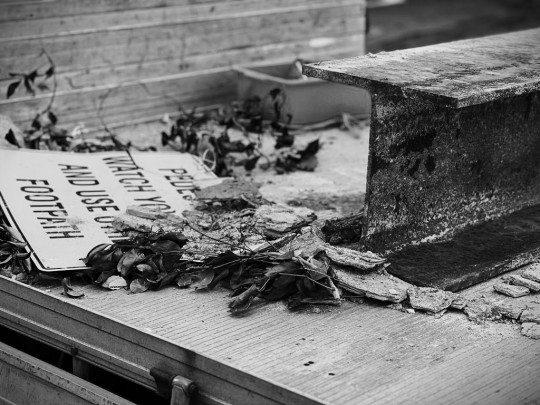
In my envisioned artwork, I also include a self-portrait with the construction debris. This personal touch emphasizes the connection between human actions and the environmental challenges we face. By placing myself within the artwork, I encourage viewers to consider their own responsibility and potential for positive change.
Drawing inspiration from Hindu architecture, which often portrays mythical stories and emphasizes the interconnectedness of beings, I aim to infuse my sculptures with symbolism and narrative. Just as Hindu architecture weaves stories of gods, goddesses, and nature, my sculptures will tell the stories of endangered species and the urgent need for their protection. This storytelling aspect will evoke empathy and foster a deeper understanding of the importance of conservation.
By comparing my artwork to the works of environmental artists, I can identify common fundamentals. Like Andy Goldsworthy's use of natural materials, I incorporate construction debris as a commentary on our impact on the environment. Like Christo and Jeanne-Claude's monumental installations, I aim to create a visual impact that sparks conversations about waste and climate change. Similar to the narrative and symbolism found in Hindu architecture, I weave stories into my artwork to engage viewers on an emotional level.
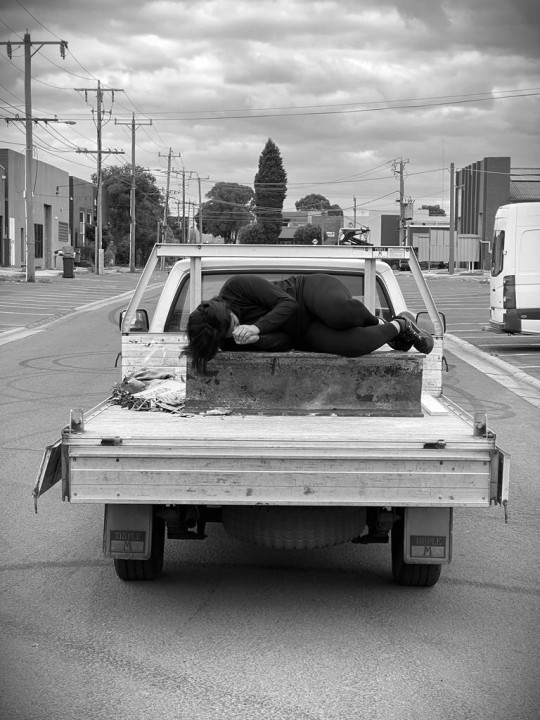
In summary, my art aspires to combine the influence of land art, eco art, and environmental artists with my background in architecture and interest in Hindu architecture. Through sculptures of endangered species displayed on construction debris, I aim to provoke thought and raise awareness about waste consumption, climate change, and the urgent need for biodiversity conservation. By incorporating storytelling and symbolism, I hope to engage viewers on a deeper level, inspiring them to take action and make a positive difference for our planet's future.
0 notes
Text
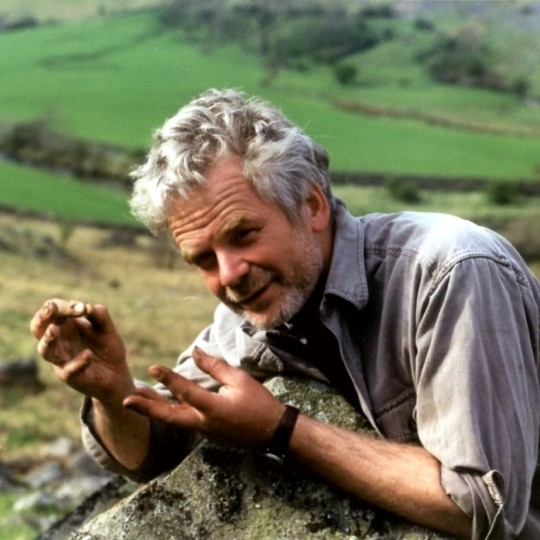
ANDY GOLDSWORTHY, "STONE RIVER"
Andy Goldsworthy's art has been a profound inspiration for my artistic journey, particularly his artwork "Stone River." This artwork, which consists of carefully arranged stones winding through a landscape, has ignited my passion to create sculptures of endangered species and display them on construction debris. By incorporating a self-portrait with the debris, I aim to raise awareness about waste consumption and climate change.
"Stone River" exemplifies Goldsworthy's deep connection with nature and his ability to create visually stunning works using found materials. The way he arranges stones to mimic the flow of a river resonates with my desire to capture the essence of endangered species within my sculptures. Just as Goldsworthy's stones seem to effortlessly blend with their surroundings, I envision my sculptures seamlessly integrated with construction debris, symbolizing the coexistence of human development and the natural world.
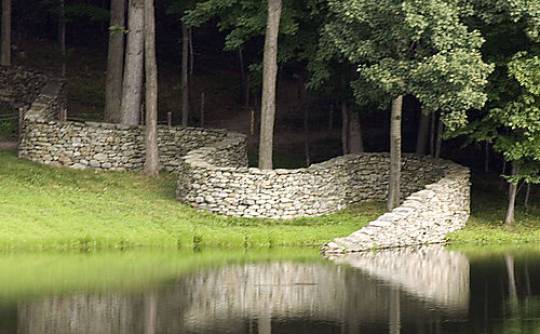
Goldsworthy's art teaches me the importance of working with materials that resonate with the message I want to convey. By utilizing construction debris, I not only draw attention to the excessive waste produced by human activities but also highlight the impact of climate change on endangered species. The juxtaposition of the sculptures and the debris, along with my self-portrait, creates a powerful visual narrative that engages viewers and prompts them to contemplate their role in environmental preservation.
Furthermore, Goldsworthy's focus on impermanence and the transient nature of his artworks inspires me to embrace the ephemeral quality of my own sculptures. Just as his art gradually disintegrates over time, my sculptures on construction debris would remind viewers of the urgency to address climate change and protect endangered species before it is too late. The impermanence serves as a metaphor for the fragility of these species and emphasizes the need for immediate action.
Goldsworthy's meticulous attention to detail and his ability to transform natural materials into art serve as guiding principles for my own artistic practice. Through careful research and understanding of each endangered species, I will create sculptures that capture their unique characteristics and tell their stories. The inclusion of a self-portrait alongside the sculptures and construction debris serves as a personal statement, reflecting my own commitment to raising awareness about environmental issues.

In conclusion, Andy Goldsworthy's artwork "Stone River" has profoundly inspired my artistic vision of creating sculptures of endangered species displayed on construction debris. His emphasis on the natural world, his use of found materials, and his exploration of impermanence have influenced my approach to creating impactful and thought-provoking artworks. Through this artistic endeavor, I aim to contribute to the conversation on waste consumption, climate change, and the urgent need to protect endangered species.
0 notes
Text
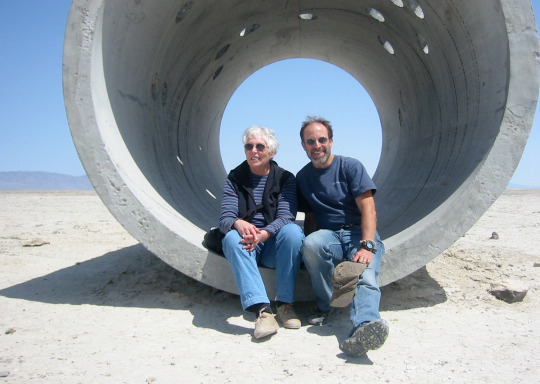
“COMPARISON BETWEEN THEO JANSEN AND NANCY HOLT”
Theo Jansen and Nancy Holt are two influential artists known for their innovative approaches to art and their deep engagement with the natural world. While their artistic practices diverge in terms of medium and focus, they share a common interest in exploring the relationship between art, nature, and human experience.
Theo Jansen is renowned for his kinetic sculptures, known as Strandbeests, which mimic the movements of living creatures. His intricate and ethereal sculptures are composed of lightweight materials such as PVC pipes and utilize wind power to create mesmerizing movements. Jansen's works blur the lines between art, engineering, and biology, as he strives to create self-propelling, evolutionary sculptures that could potentially inhabit beaches and interact with the environment. His art embodies a sense of wonder and curiosity about the mechanisms of life, inspiring viewers to contemplate the complex interconnectedness of natural systems.

Nancy Holt, on the other hand, is celebrated for her site-specific installations and earthworks that explore the perception of space, time, and light. Her most iconic work, "Sun Tunnels" (1973-1976), consists of large concrete tunnels aligned with the sun, creating ever-changing patterns of light and shadow. Holt's art invites viewers to engage with the natural environment, encouraging them to observe and contemplate their relationship to the larger cosmic order. Her installations often integrate the surrounding landscape, transforming it into a canvas for contemplation and reflection.
While Jansen's work focuses on the embodiment of movement and the potential for artificial life, Holt's art emphasizes the experiential and perceptual aspects of the natural world. Jansen's sculptures embody a dynamic and evolving presence, whereas Holt's installations invite introspection and interaction with the ever-changing qualities of light and space.

Both artists challenge traditional notions of art by expanding the boundaries of artistic practice and engaging with the environment in unconventional ways. Jansen's kinetic sculptures merge art and science, while Holt's site-specific installations merge art and the natural landscape. Through their respective approaches, Jansen and Holt inspire viewers to re-evaluate their relationship with the natural world and the possibilities of artistic expression.
In summary, Theo Jansen and Nancy Holt are notable artists who explore the intersection of art, nature, and human experience in distinctive ways. Jansen's kinetic sculptures embody the potential for artificial life, while Holt's site-specific installations invite contemplation of space and light. Their artistic practices push the boundaries of traditional art forms and encourage viewers to engage with the natural world in new and thought-provoking ways.
0 notes
Text

ROBERT SMITHSON, "NONSITES"
Robert Smithson's conceptual artwork, particularly his creation of "nonsites" using soil and mirrors, has deeply inspired me to explore the medium of sculpture in depicting endangered species. His innovative approach to art-making and his exploration of the relationship between nature and culture have shaped my own artistic journey.
Smithson's "nonsites" challenged the traditional notion of sculpture by bringing elements of the natural world into the gallery space. By collecting soil and other materials from specific locations and combining them with mirrors, he created intricate installations that transported viewers to remote environments. These works allowed me to see the potential of sculpture as a means to connect people with the natural world and to raise awareness about the fragility of endangered species.

The use of soil as a medium in Smithson's artwork resonates with my desire to represent endangered species through sculpture. Soil is the foundation of life, and by incorporating it into my sculptures, I can symbolize the vital connection between these animals and their habitats. This connection becomes even more potent when mirrored surfaces are introduced, reflecting the viewer and drawing attention to their own impact on the environment.
Smithson's emphasis on site-specificity is another aspect that has influenced my approach to creating sculptures on endangered species. Just as Smithson sought out specific locations for his "nonsites," I strive to consider the unique characteristics of the habitats of endangered species. By incorporating materials and elements from their environments into my sculptures, I can create a deeper connection between the artwork and the species it represents.
Furthermore, Smithson's exploration of the intersection between art and science has encouraged me to delve into research and scientific understanding when creating sculptures on endangered species. Understanding the ecological dynamics and the challenges faced by these animals allows me to approach my work with depth and accuracy, ensuring that my sculptures serve as accurate representations and educational tools.
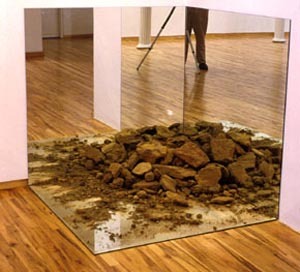

Robert Smithson's use of soil and mirrors in his "nonsites" has inspired me to explore sculpture as a means of representing endangered species. His conceptual approach, focus on site-specificity, and incorporation of natural materials have guided my artistic practice, encouraging me to create sculptures that provoke thought, raise awareness, and foster a deeper connection between viewers and the imperiled species we share our planet with.
0 notes
Text
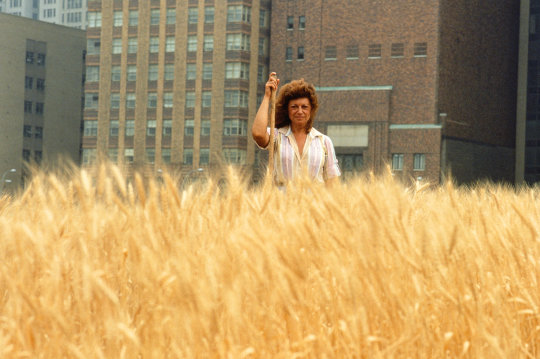
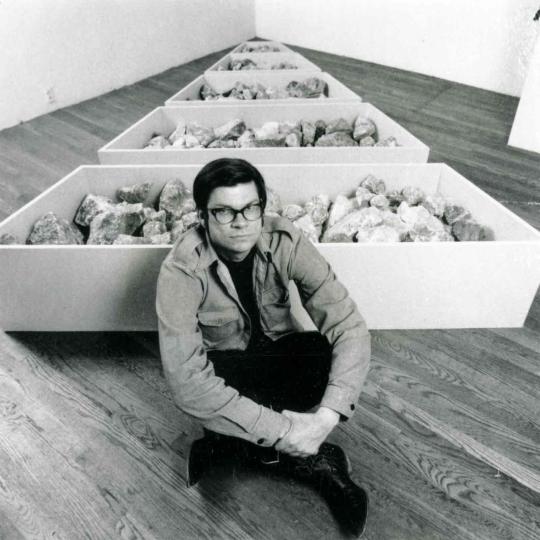
“COMPARISON BETWEEN AGNES DENES AND ROBERT SMITHSON”
Agnes Denes and Robert Smithson are both prominent artists known for their contributions to environmental and conceptual art. While their artistic approaches share some similarities, there are distinct differences in their artistic philosophies and the themes they explore.
Agnes Denes, often associated with eco art and conceptual art, focuses on themes of ecological sustainability, environmental consciousness, and the relationship between humans and nature. Denes's work often involves extensive research, scientific methodologies, and ecological interventions. She addresses urgent environmental issues through projects like "Wheatfield - A Confrontation" (1982), where she transformed a barren plot of land in Manhattan into a thriving wheatfield. Denes's art is characterized by a meticulous attention to detail, scientific precision, and a desire to create tangible connections between art and nature.
In contrast, Robert Smithson, associated with land art and post-minimalism, explores concepts of entropy, time, and the relationship between art and the landscape. Smithson's most famous work, "Spiral Jetty" (1970), involved the construction of a massive spiral-shaped landform in the Great Salt Lake. His art often involves altering the natural environment and integrating man-made materials with natural elements. Smithson's work emphasizes the cyclical nature of time and the transformation of landscapes, inviting viewers to contemplate the impermanence and interconnectedness of existence.


While both Denes and Smithson engage with the environment in their artistic practice, Denes's work tends to be more explicitly focused on environmental activism and sustainability, utilizing scientific methods and interventionist approaches. Smithson, on the other hand, explores the metaphysical aspects of the landscape, emphasizing the relationship between art and nature through transformative interventions.
Additionally, Denes's art often emphasizes the human impact on the environment and our responsibility towards ecological preservation. Smithson's work, while acknowledging human presence, delves more into the philosophical and geological aspects of the landscape.
Agnes Denes and Robert Smithson make significant contributions to environmental and conceptual art but with distinct approaches. Denes's work centres around ecological activism and scientific interventions, while Smithson's art explores the metaphysical and temporal dimensions of the landscape. Both artists challenge traditional notions of art and provoke viewers to contemplate our relationship with the natural world.
3 notes
·
View notes
Text
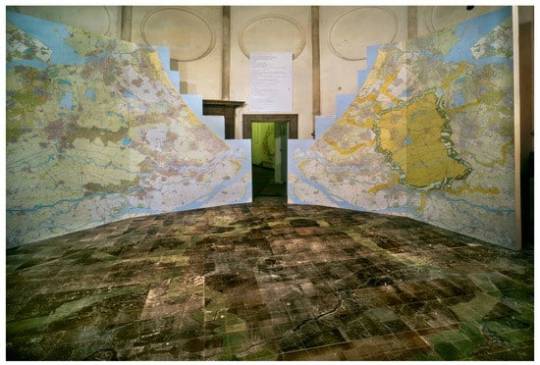
NEWTON HARRISON, "A VISION FOR THE GREEN HEART OF HOLLAND"
Newton's art project "A Vision for the Green Heart of Holland" from 1984 has ignited a profound inspiration within me to undertake a monumental endeavor of creating sculptures of endangered species for an entire country. This visionary project has fueled my passion to raise awareness and engage the public in understanding the urgent situation faced by endangered species.
"A Vision for the Green Heart of Holland" showcased Newton's imagination and dedication to transforming landscapes through art. The project aimed to integrate large-scale sculptures into the natural environment, creating a harmonious coexistence between art and nature. This ambitious undertaking resonates with my own aspirations to use sculpture as a means to advocate for endangered species on a grand scale.

The notion of creating sculptures of endangered species for an entire country is a compelling and impactful approach. By strategically placing these sculptures throughout different regions, we can capture the attention of diverse communities and foster a sense of collective responsibility for the conservation of these species. The visual presence of these sculptures will serve as a constant reminder of the urgent need for action.
Inspired by Newton's project, I envision sculptures that capture the essence and beauty of endangered species, while also embodying the threats they face. Each sculpture would be meticulously designed to reflect the unique characteristics and habitat of the species it represents, creating an emotional connection between viewers and the natural world.
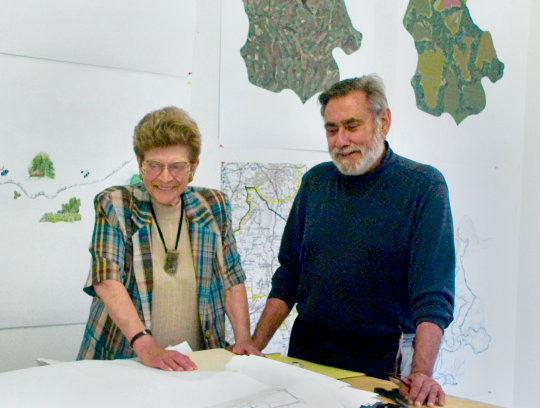
Furthermore, this ambitious project presents an opportunity to engage with local communities and organizations. Collaborating with conservation groups, educational institutions, and government bodies, we can leverage the power of art to educate and inspire collective action. Workshops, exhibitions, and educational programs can be organized to deepen public understanding and mobilize support for conservation efforts.
By undertaking a project of this scale, we have the potential to make a significant impact. Newton's art project has shown us that art has the power to transform and ignite change. By creating sculptures of endangered species for an entire country, we can awaken public consciousness, foster a sense of stewardship, and rally individuals, communities, and institutions towards protecting our planet's invaluable biodiversity.
In essence, "A Vision for the Green Heart of Holland" has propelled me to embark on an ambitious journey to create sculptures of endangered species for a whole country. By drawing inspiration from Newton's vision and harnessing the power of art, I aim to raise awareness, promote conservation, and cultivate a shared commitment to safeguarding our natural heritage for generations to come.
0 notes
Text
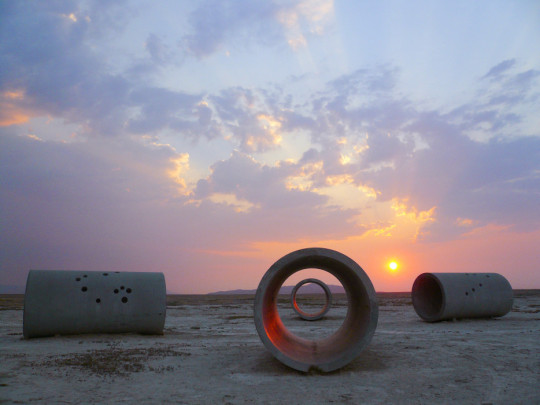
NANCY HOLT, "SUN TUNNELS"
Nancy Holt's art, particularly her visionary work "Sun Tunnels," has had a profound impact on me as a female environmental artist. Her pioneering spirit and dedication to merging art and nature have served as an inspiration for my own artistic journey.
"Sun Tunnels" is a powerful testament to Holt's innovative approach and her ability to transform the natural landscape into a canvas for artistic expression. These large-scale concrete tunnels, precisely aligned with the sun, create a mesmerizing interplay of light and shadow, encouraging viewers to contemplate their place within the vastness of the natural world.
As a female artist, Holt's ability to create monumental land art installations resonates deeply with me. She defied societal expectations and broke barriers in a male-dominated field, proving that women have a powerful voice and unique perspective to contribute to the environmental art realm. Her success serves as a reminder that as female artists, we can make a significant impact and bring attention to important ecological issues.

Holt's work also underscores the importance of connection and interaction with nature in art. "Sun Tunnels" invites viewers to engage with the landscape, to observe the ever-changing play of light and experience a sense of awe and wonder. This immersive experience echoes my own desire to create art that encourages a deep and meaningful connection between viewers and the natural world.
Moreover, Holt's focus on site-specificity in her art has taught me the value of understanding and responding to the unique qualities of a particular environment. By studying the natural elements and ecosystems, I can create artwork that is harmonious with the surroundings and invites viewers to develop a deeper appreciation for the beauty and fragility of the natural world.
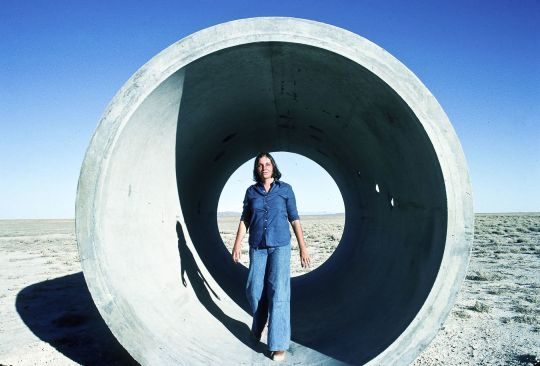
In Nancy Holt's art, I find a kindred spirit—a female artist who fearlessly merged her artistic vision with environmental concerns. Her pioneering approach and ability to create profound experiences through her artwork have inspired me to follow in her footsteps. As a female environmental artist, I strive to emulate her dedication to nature, her artistic innovation, and her commitment to raising awareness about ecological issues through my own creative endeavours.
0 notes
Text
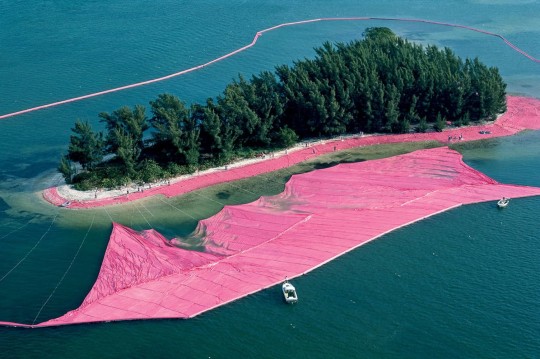
“LAND ART”
As an environmental artist seeking to create sculpture art focused on endangered species, I find that land art offers me a valuable tool to express my vision and promote environmental awareness. It provides a unique set of benefits that shape my artistic journey and contribute to the impact I aspire to make.
First and foremost, land art allows me to establish a profound connection with the environment. By working directly with natural materials and engaging with the landscape, I deepen my understanding and appreciation of the habitats where endangered species reside. This intimate connection informs and enriches my artwork, enabling me to capture the essence and significance of these fragile ecosystems.
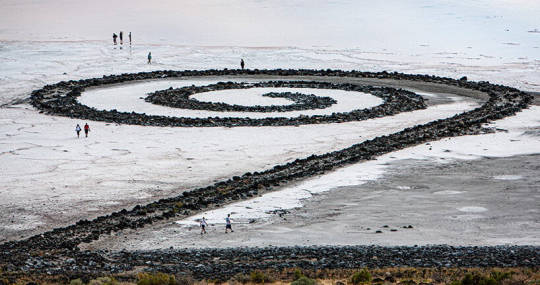
Furthermore, land art promotes sustainability and eco-friendly practices, which align perfectly with my artistic ethos. By utilizing materials found in nature and adopting low-impact techniques, I can create sculptures that resonate with the principles of conservation. Incorporating recycled or biodegradable materials in my artwork highlights the importance of sustainable practices and draws attention to the urgent need for environmental stewardship.
A key aspect of land art is its site-specific nature, which I incorporate into my sculptures for endangered species. By considering the specific characteristics and habitats of the animals I aim to depict, I design sculptures that harmonize with their natural surroundings. This approach enhances the storytelling aspect of my art, forging a deeper connection between the artwork, the species, and their environment.
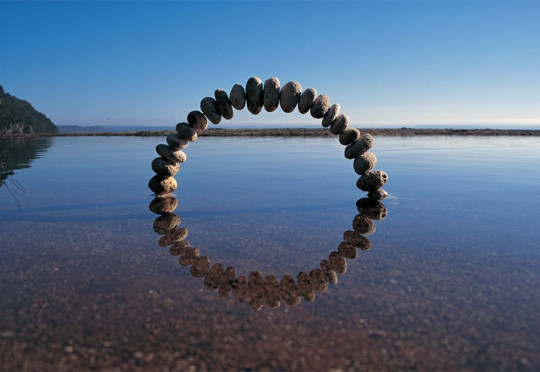
One of the strengths of land art is its ability to engage communities and foster dialogue. I leverage this aspect to raise awareness about endangered species and their conservation. Through workshops and community involvement, I encourage others to take part in the creation process, fostering a sense of shared responsibility and deepening their understanding of the issues at hand.
Lastly, the temporary and impermanent nature of land art serves as a powerful symbol of the precariousness of endangered species. By creating sculptures that gradually erode or change over time, I evoke a sense of urgency and the need for immediate action. This impermanence acts as a poignant reminder of the fleeting nature of these species, inspiring viewers to join the conservation efforts.
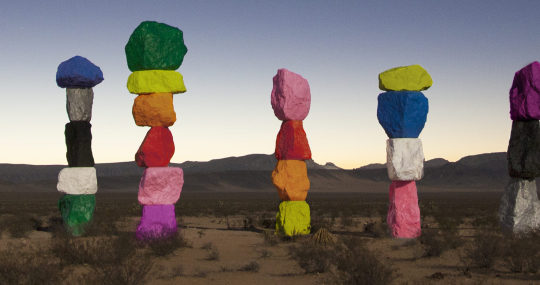
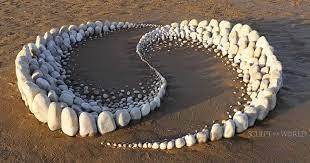
0 notes
Text

“HINDU ARCHITECTURE”
As an environmental artist, I have found immense inspiration in Hindu architecture and its art of storytelling. Hindu architecture, with its intricate carvings and sacred symbolism, provides a rich tapestry of narratives that can be harnessed to create meaningful art that raises awareness about endangered animals.
Hindu architecture, particularly in temples, is renowned for its elaborate sculptures and reliefs that depict various mythological tales and religious narratives. These stories often revolve around gods, goddesses, and their interactions with nature and wildlife. The artistry of these sculptures is awe-inspiring, capturing the essence of the stories and imbuing them with spiritual significance.

Drawing upon this tradition, I aim to use my art practice to depict the stories of endangered animals. Just as Hindu architecture uses art to convey narratives and impart moral lessons, I believe that art can be a powerful tool for raising awareness about the plight of endangered species and the urgent need for their conservation.
Through my artwork, I strive to capture the essence and beauty of these endangered animals, while also weaving in the narratives and symbolism found in Hindu mythology. I depict the animals in their natural habitats, surrounded by the flora and fauna that are integral to their survival. By incorporating elements of Hindu storytelling, I hope to evoke a sense of empathy and connection with these endangered creatures.

The art of storytelling in Hindu architecture also teaches us about the interconnectedness of all living beings. These stories emphasize the harmony between humans, animals, and the environment, highlighting the need for balance and respect in our interactions with nature. By portraying endangered animals in my artwork, I aim to emphasize this interconnectedness and the profound impact that the loss of these species can have on our world.
Hindu architecture and its art of storytelling have become an integral part of my art practice as an environmental artist. By depicting the stories of endangered animals, I aim to bring attention to their plight and inspire viewers to take action for their conservation. Through the merging of sacred symbolism, mythology, and the urgency of environmental issues, I hope to foster a deeper connection with nature and promote a sense of responsibility towards the preservation of our planet's diverse and endangered species.

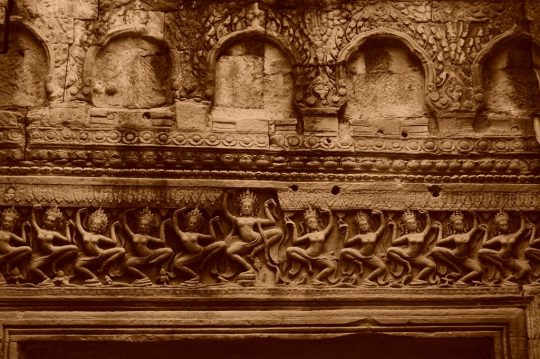
0 notes
Text

“BIOMIMICRY ART”
As an environmental artist, the concept of biomimicry art has deeply influenced my artistic journey, sparking a profound appreciation for the beauty and wisdom found in nature. Biomimicry art is the practice of drawing inspiration from the forms, processes, and systems found in the natural world and integrating them into artistic creations.
Exploring biomimicry art has opened my eyes to the intricate patterns, colours, and structures that exist in the flora and fauna around us. It has allowed me to observe and understand nature on a deeper level, capturing the essence of its harmony and balance. Through this practice, I have learned to appreciate the incredible efficiency and sustainability of natural systems.

Biomimicry art holds immense importance in my artistic journey as an environmental artist. It serves as a guiding principle, reminding me of the importance of coexisting with nature rather than exploiting it. By emulating nature's design principles and processes, I aim to create art that not only captures the beauty of the natural world but also promotes sustainability and ecological awareness.
Biomimicry art has become a source of inspiration for my creative process. It encourages me to study the intricacies of nature, to observe the way light filters through leaves or the way a bird's wings move gracefully through the air. By incorporating these observations into my artwork, I strive to evoke a sense of connection and reverence for the environment.
Furthermore, biomimicry art serves as a catalyst for innovation and problem-solving. Nature has perfected its designs through millions of years of evolution, and by studying its solutions, we can find sustainable answers to our own challenges. It pushes me to explore alternative materials, energy-efficient designs, and regenerative systems in my artistic practice, reflecting the resilience and adaptability of the natural world.

Biomimicry art has become an integral part of my artistic journey as an environmental artist. It fuels my creativity, deepens my connection with nature, and guides my approach to sustainability. By drawing inspiration from the brilliance of the natural world, I hope to create art that not only captivates viewers but also encourages them to cherish and protect our precious planet.
3 notes
·
View notes
Text
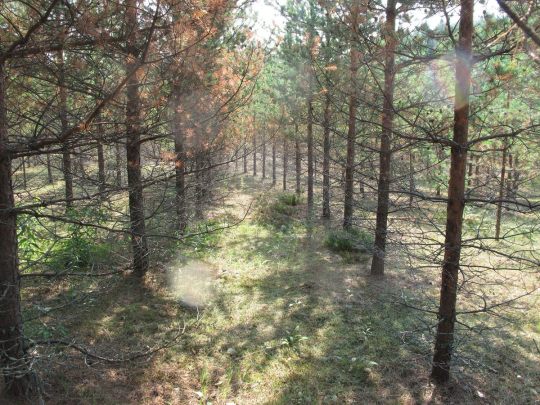
“THE TREE MOUNTAIN PROJECT”
Upon discovering the Tree Mountain project, my spirit soared with excitement as the concept of blending art and nature unfolded before my eyes. Reading about this environmental masterpiece filled me with awe and wonder, igniting a fire within me to explore the depths of my own artistic expression.
The visionary artist Agnes Denes created a monumental work of art by transforming a barren gravel pit into a thriving forested mountain. The sheer audacity and ambition of this project astounded me. I imagined the vastness of the landscape, once void of life, now adorned with countless trees. It was as if Denes had breathed life into the earth itself.

The symbolism behind Tree Mountain resonated deeply with my own environmental beliefs. It stood as a testament to the power of nature's resilience and our responsibility as custodians of the Earth. This living artwork would not only provide a sanctuary for countless plant and animal species but also serve as a powerful reminder of our interconnectedness with the natural world.
As an environmental artist, the Tree Mountain project inspired me to contemplate the transformative potential of art. It reminded me that our creations can transcend aesthetics and become catalysts for change. Denes had taken a scarred piece of land and sculpted it into a living testament to the regenerative capacity of our planet.
The profound impact of Tree Mountain extended beyond its physical manifestation. It challenged the conventional notions of what art could be, pushing boundaries and embracing the environment as a canvas. It made me question the role of art in society and the potential for artists to be agents of ecological transformation.
My encounter with the Tree Mountain project evoked a profound sense of purpose and motivation. It urged me to embark on my own artistic journey, exploring the intersection of art and the environment. Denes's masterpiece will forever serve as a beacon of inspiration, reminding me of the immense power artists wield in shaping our relationship with the natural world.
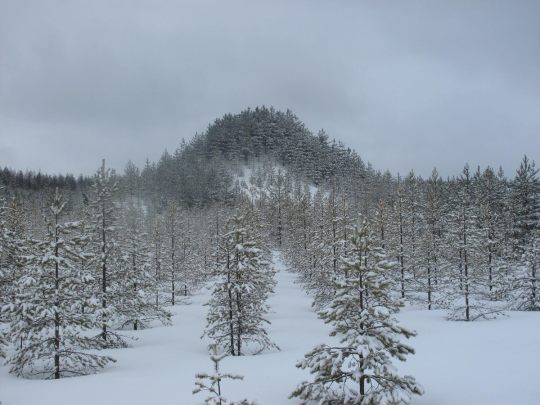
0 notes
Text

"SPECIES RECLAMATION VIA A NON-LINEAR GENETIC TIMELINE: AN ATTEMPTED HYMENOCHIRUS CURTIPES MODEL INDUCED BY CONTROLLED BREEDING."
As an environmental artist, I recently stumbled upon the fascinating eco art project by Brandon Ballengee titled "Species Reclamation Via a Non-linear Genetic Timeline: An Attempted Hymenochirus curtipes Model Induced By Controlled Breeding." Intrigued by the concept, I delved into the depths of its description, and my imagination soared.
The mere mention of "Species Reclamation" ignited a spark within me. Ballengee's endeavor to restore a species through controlled breeding resonated deeply with my own artistic aspirations. The Hymenochirus curtipes, a delicate African frog, served as the subject of this ambitious experiment. Imagining the intricate beauty of these creatures, I was captivated by the possibility of their revival.
Ballengee's approach, a non-linear genetic timeline, added an element of mystery and wonder to the project. It seemed as though time itself would become a medium for artistic intervention, guiding the path of genetic development. I imagined the artist's careful calculations, painstakingly orchestrating the breeding process to evoke a desired outcome.
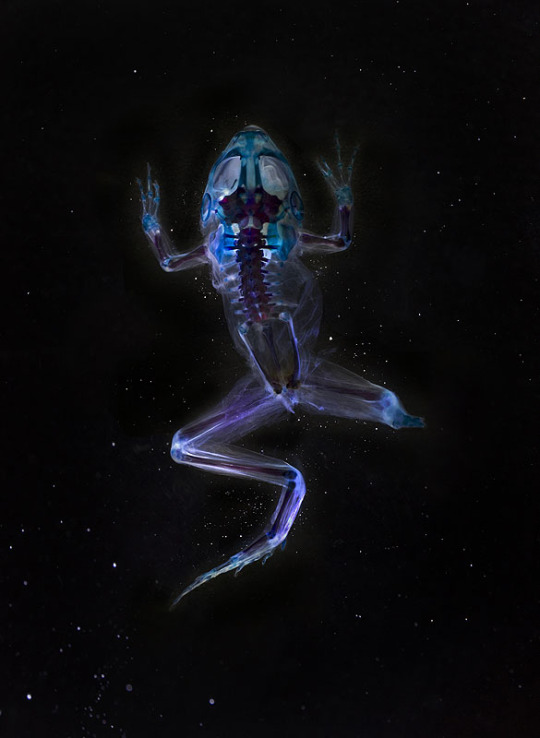
Contemplating the implications of this project, I was moved by the inherent connection between art and the natural world. It reminded me that as artists, we possess the power to not only capture the essence of nature but also actively participate in its preservation. The responsibility of representing the fragile beauty of species in peril became clear to me.
This exploration of eco art left me inspired and contemplative, questioning the boundaries of artistic expression. Ballengee's project taught me that as an artist, I can contribute to important conversations surrounding environmental conservation and biodiversity. Through my art, I can shed light on the urgent need to protect and restore our delicate ecosystems.

0 notes
Text
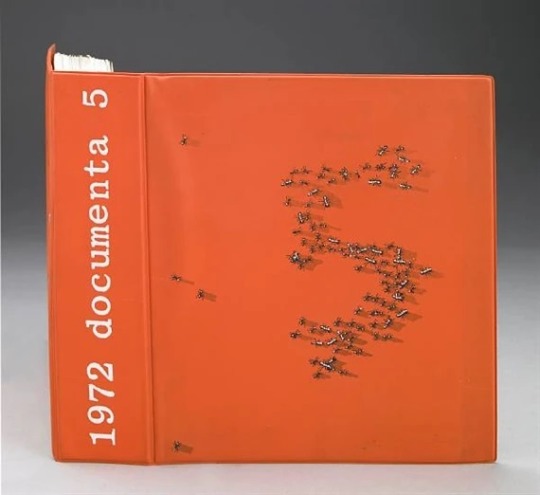
DOCUMENTA 5": UNLEASHING THE POWER OF ARTISTIC REBELLION
As a budding artist, "Documenta 5" was a mind-altering experience that opened my eyes to the boundless possibilities of artistic expression. Curated by Harald Szeemann, this ground-breaking exhibition shattered conventions and ignited a rebellion against the status quo, challenging the very essence of what art can be.
One of the most striking aspects of "Documenta 5" was its rejection of traditional boundaries. The exhibition blurred the lines between disciplines, embracing a multitude of artistic forms, including installations, performances, films, and conceptual pieces. This fearless exploration pushed me to question my own preconceptions and embark on a journey of artistic discovery.

The curatorial vision of Szeemann was revolutionary. The exhibition became a vibrant tapestry of diverse voices, showcasing artists from around the world who defied societal norms and pushed the limits of creativity. Their works addressed pressing political and social issues, unapologetically confronting the injustices and inequalities of the time.
"Documenta 5" also challenged the passive role of the viewer, actively engaging audiences in a dynamic dialogue. The exhibition fostered a participatory environment, inviting visitors to question, interpret, and even interact with the artworks. This immersive experience ignited a spark within me, as I realized the transformative power of art lies not only in its creation but also in its impact on the audience.
Moreover, "Documenta 5" sparked critical discourse and debates, amplifying the voices of marginalized communities and challenging established hierarchies within the art world. It demonstrated that art can be a catalyst for social change, a powerful tool for dismantling oppressive structures and envisioning alternative futures.
As a budding artist, "Documenta 5" emboldened me to reject artistic boundaries and embrace experimentation. It showed me that art can transcend mediums and embrace a multiplicity of voices. The exhibition inspired me to question, challenge, and create work that pushes the boundaries of my own artistic practice.
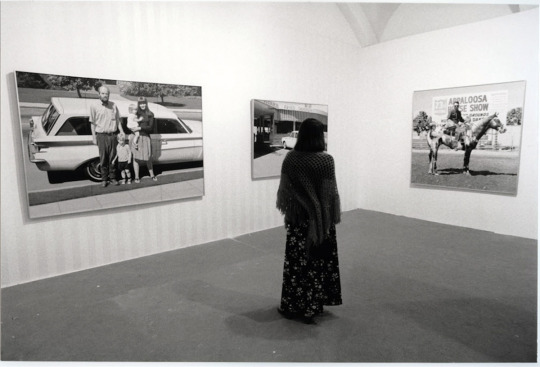
In conclusion, "Documenta 5" was a transformative experience for me as a budding artist. It shattered conventions, encouraged active engagement, and amplified the voices of the marginalized. This exhibition empowered me to embrace rebellion in my art, to challenge the status quo, and to harness the power of creativity for social change.
1 note
·
View note
Text

"WHEATFIELD - A CONFRONTATION": A POWERFUL MANIFESTATION OF ENVIRONMENTAL
As a budding environmental artist, I was deeply moved by the thought-provoking installation "Wheatfield - A Confrontation." This ground-breaking work by Agnes Denes serves as a powerful manifestation of environmental consciousness, challenging societal norms and urging us to confront the pressing issues surrounding our relationship with nature.
The installation itself was awe-inspiring—a vast field of wheat, meticulously cultivated amidst an urban landscape. Denes transformed a barren plot of land into a flourishing symbol of life and sustenance. This juxtaposition of nature and human-made structures emphasized the stark contrast between our modern world and the essential harmony we often neglect.
The process of growing and maintaining the wheatfield became a performance in itself, highlighting the labour and care required to nurture and sustain the natural world. It served as a potent reminder of our interconnectedness with the environment and the responsibility we bear as custodians of the Earth.
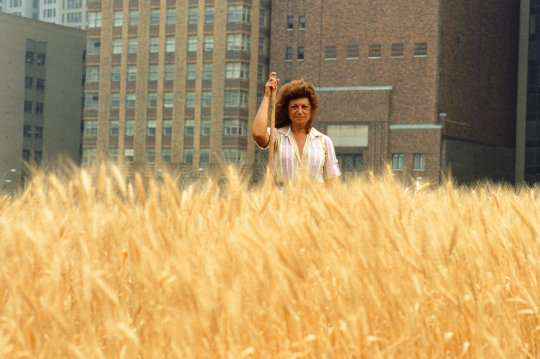
Denes' work confronted viewers with the consequences of our actions, urging us to reconsider our role in the ecological crisis. The wheatfield, both visually captivating and emotionally charged, served as a metaphor for the potential for regrowth and renewal. It sparked a dialogue on the destructive forces of urbanization and industrialization, inviting us to reflect on the delicate balancebetween progress and preservation.
As a budding environmental artist, "Wheatfield - A Confrontation" served as an inspiration and a call to action. It reaffirmed the transformative power of art in raising awareness and inciting change. Denes' installation demonstrated that art has the ability to transcend the gallery walls and infiltrate public consciousness, prompting us to re-evaluate our relationship with nature and encouraging us to adopt more sustainable practices.

0 notes
Text

"A MENAGERIE OF CULTURAL KNOWLEDGE AND KINGSHIP"
As I immersed myself in the mesmerising exhibition titled "A Menagerie of Cultural Knowledge and Kingship," I embarked on a hypnotic voyage through the domains of cultural wealth and regal splendour. The curated collection of artefacts, artworks, and historical remnants from different cultures and periods captivated my attention and instilled in me a profound appreciation for the rich diversity of human knowledge. As an aspiring artist, reading about this exhibition inspired me to integrate indigenous culture into my art practise and raise awareness about indigenous species that are threatened with extinction. In my art, I am returning to the origins of Hindu architecture and selecting the art of narrative telling from Hindu architecture. I felt compelled by the experience of this exhibition to use my art to raise awareness about indigenous species in peril of extinction. I endeavour to celebrate their profound connection to nature and harmonious coexistence with the environment, drawing inspiration from the indigenous cultures represented in the exhibition. Through my artistic endeavours, I hope to bring attention to the critical need for the conservation and preservation of these rare and vulnerable species. By integrating my artwork with the aesthetics, symbolism, and narratives of Hindu architecture, I hope to engage viewers in a conversation about the profound interdependence between ancient cultures and their natural environments. Through this combination of artistic expression and environmental consciousness, I hope to contribute to the preservation of ancient heritage and promote a greater appreciation for the significance of protecting the planet's biodiversity.
0 notes
Text

A JOURNEY INTO THE MIND-BENDING WORLD OF PIERRE HUYGHE AT DOCUMENTA 13
As a young artist investigating the limits of creativity, I was captivated by Pierre Huyghe's mind-bending installations and thought-provoking ideas. The installations of Huyghe defy conventional conceptions of art by immersing viewers in alluring environments that challenge our perception of reality. "Untilled," a living ecosystem constructed within the exhibition space, was one such experience. As I wandered through a thick fog and encountered a woman with a beehive on her head, I could not help but experience awe and bewilderment. I questioned my own perceptions of the world around me as the distinctions between the natural and artificial became less distinct. My immature artistic mind was profoundly affected by Huyghe's investigation of time and memory. I connected strongly with Huyghe's emphasis on collaboration and the force of collective imagination in his work. I must confess that I did not fully comprehend certain aspects of Huyghe's work. I felt somewhat overwhelmed by the complexity of his ideas and the layered symbolism embedded in each installation. Nevertheless, I believe that this is precisely the appeal of Huyghe's art; it forces us to confront our own limitations and encourages us to investigate deeper into the intricacies of the human experience.
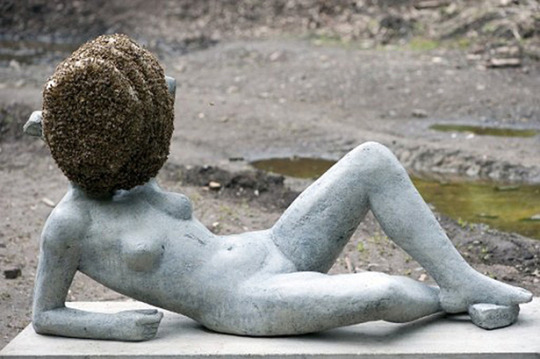
The contributions of Pierre Huyghe to Documenta 13 challenged my preconceived notions of what art can be. Through his immersive installations, investigation of time and memory, and emphasis on collective imagination, Huyghe drew me into a domain in which the boundaries of reality dissolved. Despite the fact that my immaturity may have hindered my complete comprehension, I left this exhibition with a deeper appreciation for the transformative force of art. I will always remember Documenta 13 as a testament to the limitless possibilities of artistic expression.

2 notes
·
View notes
Text


Self Reflection
This semester, I developed my deep voice in Frameworks A. In this class, I spoke and participated in different conversations, debates, and information exchanges on various elements of art and the arts itself. The course instilled in me many qualities relating to art and its processes that I had never considered and that my culture had never taught me. Through this dossier, I hope to express all of my thoughts, and ideas idle, and deepen my attention by conducting a study on many Climate changes and environmental subjects, as well as the ideals of other artists.
I have been advocating for endangered species of the world through my art for the past 2 semesters and will keep doing my best for them. I have a severe phobia of all animals due to an accident when I was just over 2 years old, but I realized I can only feel for them. I cannot go near them or look at them because I won’t be able to sleep at night but I still want to work for them after coming to Melbourne I was lost, physically, emotionally, and spiritually but Critical Framework A course somehow brings me back to my senses, I randomly started talking about my inner feelings about various topics and that helped me get over my blue, I’m glad that I took this course and could return back to my old self. I started reading various random books which I read when I was finding my way into the art industry.

As an architect, I love designing spaces and love to fill the spaces with lots of colors, which is why I started turning towards art and the environment. CFA helped me go back to my own journey again and refreshed my whole intention of mine to attempt to do art and cater to the environment. I read about my culture, read about many artists, and watch many art exhibitions, which I mentioned in the first assignment, and in this assignment.
Through this dossier I created my little map and constructed a paved path for my upcoming semester, now I’m more confident now in myself and do not want to look back again. This course is the most important course of my life and I will be remembering it till I stop doing art. I wanted to include another post regarding “why I should use organic material as an Environmental artist?” and “why I want to use non-recyclable and non-usable material as an Environmental Artist?” and I’m still in the middle of the research.
0 notes